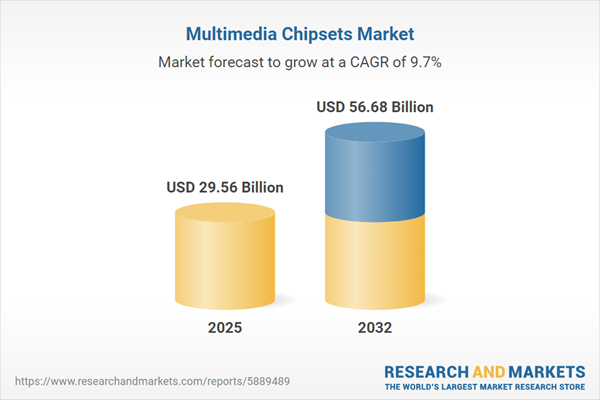Speak directly to the analyst to clarify any post sales queries you may have.
The multimedia chipsets market is reshaping enterprise digital strategies, unlocking advanced capabilities that enable organizations to modernize, maintain operational agility, and address compliance in diverse regulatory environments.
Market Snapshot: Multimedia Chipsets Market
Global demand for multimedia chipsets continues to accelerate as enterprises focus on digital transformation and seamless connectivity. In 2024, the multimedia chipsets market is valued at USD 26.93 billion, with an expected growth to USD 29.56 billion by 2025. This trajectory is set to reach USD 56.68 billion by 2032, fueled by a robust CAGR of 9.74%. This growth is driven by innovation within the semiconductor landscape, evolving international standards, and an increased focus on building agile and compliant systems. Decision-makers in automotive, consumer electronics, and industrial sectors are now prioritizing multimedia chipset integration to stay competitive and flexible. As global regulations become more intricate, solutions tailored to local compliance and enhanced by edge intelligence are gaining traction in supporting resilient enterprise operations.
Scope & Segmentation of the Multimedia Chipsets Market
- Device Types: Automotive systems embed multimedia chipsets to upgrade driver assistance, telematics, and infotainment capabilities, enabling both productivity and safety improvements. Consumer electronics, from cameras to tablets and smart televisions, rely on these technologies for efficient performance in commercial and residential contexts. Smartphones, wearables, augmented reality glasses, and fitness trackers expand the range of use, catering to both business and personal needs.
- Chipset Types: Digital signal processors support advanced multimedia and communication functionalities, improving outcomes across organizational settings. Field-programmable gate arrays allow agile adaptation and customization of systems, while graphics processing units meet the needs of high-performance visual applications. System-on-chip platforms offer compact solutions for automation and smart business environments.
- Connectivity Standards: Integration of 4G, 5G, Wi-Fi variants (including G, N, AC, and AX), and Bluetooth ensures reliable compatibility and continuity, especially in distributed enterprise environments.
- End User Industries: Automotive, commercial, residential, telecom, healthcare, manufacturing, aerospace, and energy sectors each drive specific technology and compliance requirements. These industries influence solution development, emphasizing alignment with stringent regulations unique to each sector.
- Geographical Coverage: The Americas, EMEA, and Asia-Pacific regions each reflect distinct trends in technology adoption, market competition, and regulatory outlook. This variation underscores the necessity for effective localization and adaptation strategies, particularly in industries whose compliance requirements diverge by region.
- Key Companies Covered: Qualcomm Incorporated, MediaTek Inc., Samsung Electronics Co., Ltd., Intel Corporation, Broadcom Inc., NVIDIA Corporation, Advanced Micro Devices, Inc., Texas Instruments Incorporated, STMicroelectronics N.V., and Realtek Semiconductor Corp. shape the competitive landscape, leveraging insights and strategies tailored to regional and industry-specific demands.
Key Takeaways for Senior Decision-Makers
- System-on-chip architectures facilitate scalable and unified IoT, automotive, and smart device platforms, supporting business goals across multiple scenarios and deployments.
- Software-defined hardware supports greater customization, allowing organizations to tailor technology adoption while minimizing interruptions to established operational investments.
- Comprehensive multimedia chipset solutions enhance resilience, supporting organizations as they adapt to regulatory changes and uphold robust asset management practices.
- Collaboration with semiconductor, hardware, and cloud technology providers ensures enterprise deployments are strategically aligned with business performance and compliance priorities.
- Sustainable and ethically sourced chipsets are key to fostering long-term supplier relationships, enhancing brand trust, and ensuring future-proof compliance across industries.
- Adherence to open standards helps standardize interoperability, paving the way for smooth technological and regulatory transitions as industries evolve.
Tariff Impact on Multimedia Chipset Supply Chains
Recent tariff developments in the United States have prompted enterprises to re-evaluate global supplier networks. To mitigate risks from shifting trade policies, organizations are diversifying their supplier base and increasing regional production capabilities. Senior leaders are leveraging digital sourcing platforms and predictive analytics to fortify supply chain stability, enhancing their ability to respond dynamically to changing market and regulatory requirements.
Methodology & Data Sources
This report integrates robust secondary research with direct feedback from engineers, procurement specialists, and supply chain executives. Validation is achieved through the review of patents, targeted regulatory analyses, industry-wide surveys, and expert interviews, ensuring the accuracy and applicability of insights for executive-level planning.
Why This Report Matters for Senior B2B Leaders
- Enables risk-aware, data-driven decision-making by providing timely insights essential for strategic technology and procurement planning.
- Supports robust and adaptive sourcing strategies that promote operational resilience and sustainable growth amid evolving global conditions.
- Reinforces confidence in investment decisions by supplying actionable intelligence to maintain strong sector positioning during market transitions.
Conclusion
Senior leaders can leverage this analysis to guide multimedia chipset adoption, enhance operational agility, and sustain long-term organizational success as industry and regulatory requirements continue to evolve.
Additional Product Information:
- Purchase of this report includes 1 year online access with quarterly updates.
- This report can be updated on request. Please contact our Customer Experience team using the Ask a Question widget on our website.
Table of Contents
3. Executive Summary
4. Market Overview
7. Cumulative Impact of Artificial Intelligence 2025
Companies Mentioned
The companies profiled in this Multimedia Chipsets market report include:- Qualcomm Incorporated
- MediaTek Inc.
- Samsung Electronics Co., Ltd.
- Intel Corporation
- Broadcom Inc.
- NVIDIA Corporation
- Advanced Micro Devices, Inc.
- Texas Instruments Incorporated
- STMicroelectronics N.V.
- Realtek Semiconductor Corp.
Table Information
| Report Attribute | Details |
|---|---|
| No. of Pages | 191 |
| Published | October 2025 |
| Forecast Period | 2025 - 2032 |
| Estimated Market Value ( USD | $ 29.56 Billion |
| Forecasted Market Value ( USD | $ 56.68 Billion |
| Compound Annual Growth Rate | 9.7% |
| Regions Covered | Global |
| No. of Companies Mentioned | 11 |









